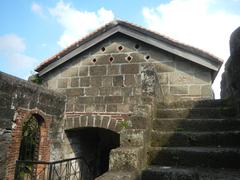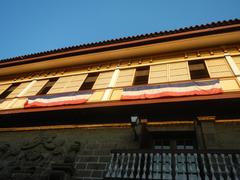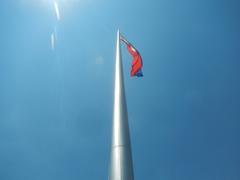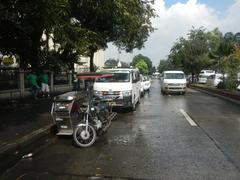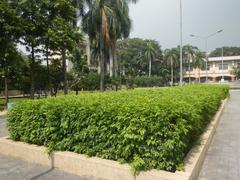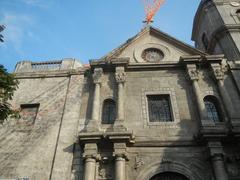Comprehensive Guide to Visiting Taguig, Metro Manila, Philippines
Date: 13/08/2024
Captivating Introduction
Picture this: Taguig, Metro Manila, a city where ancient tales and modern marvels intermingle like old friends catching up over coffee. Once a bustling part of the Kingdom of Tondo, Taguig has transformed through centuries of colonial influence, war, and rapid urbanization into a vibrant metropolis that never sleeps. It’s a place where historical whispers echo through the streets and skyscrapers reach for the stars. Imagine walking through Bonifacio Global City (BGC), often dubbed as the ‘Little Singapore’ of the Philippines, with its eco-friendly buildings and green spaces that seem to breathe life into the urban jungle. From the solemn serenity of the Manila American Cemetery to the lively chaos of the Taguig River Festival, the city offers a sensory feast for the curious traveler. Intrigued? Let’s embark on this journey through time and space, exploring Taguig’s rich history, cultural vibrancy, and modern allure. Ready to dive in? (Taguig News, Island Times).
Table of Contents
Taguig: A Journey Through Time
Early History and Founding
Taguig, nestled in the bustling heart of Metro Manila, Philippines, is a city where the past and present collide in the most fascinating ways. Centuries ago, Taguig was a vibrant part of the Kingdom of Tondo, bustling with the advanced agricultural practices and lively trade of the Tagalog people.
Spanish Colonial Period
Fast forward to the 16th century, and Spanish galleons arrive on the shores, forever changing the landscape of Taguig. Officially established as a pueblo in 1587, the Spanish influence is still visible today, especially with the construction of the Santa Ana Church, one of the oldest churches in the country.
American Era
The turn of the 20th century brought yet another transformation. The Americans took over, and in 1901, Fort William McKinley was established. This military reservation, which would later become Fort Bonifacio, was pivotal during World War II. Today, it’s a bustling district teeming with skyscrapers, posh cafes, and vibrant nightlife.
World War II and Japanese Occupation
The shadow of World War II loomed large over Taguig. The Japanese occupation from 1942 to 1945 brought hardships that are poignantly remembered at the Manila American Cemetery and Memorial. Over 17,000 American and Filipino soldiers rest here, their stories etched in the serene landscape.
Post-War Development
In the aftermath of war, Taguig rose like a phoenix. The Heroes Cemetery (Libingan ng mga Bayani), established in 1947, stands as a solemn tribute to Filipino soldiers. It’s a place of reverence, where each grave tells tales of bravery and sacrifice.
Modern Era and Urbanization
From the 1990s onwards, Taguig has been on a rocket-fueled journey to modernization. The development of Bonifacio Global City (BGC) turned it into a premier business and lifestyle hub. Picture glitzy skyscrapers, trendy boutiques, and bustling streets where dreams take flight.
Cultural Significance
Taguig is not just about its historical milestones; it’s also a living, breathing tapestry of cultural vibrancy. The annual Taguig River Festival is a riot of colors, music, and dance. From traditional crafts to culinary delights, Taguig’s culture is as diverse as its history.
Key Historical Sites
Heroes Cemetery (Libingan ng mga Bayani)
Established in 1947, this cemetery is dedicated to Filipino soldiers. Rows upon rows of crosses stand as testaments to the sacrifices made for the nation’s freedom.
Manila American Cemetery and Memorial
Located on the former Fort William McKinley Air Force Base, this 150-acre site holds the remains of American service members. Open daily, it’s a significant site for American families and military history enthusiasts alike.
Santa Ana Church
Built in 1587, the Santa Ana Church is a living relic of the Spanish colonial era. Walking through its ancient doors, you can almost hear the whispers of centuries past—a must-visit for history buffs and curious travelers alike.
Significance and Modern Development
Historical Significance
Taguig, a city in Metro Manila, Philippines, has roots that stretch back to pre-colonial times. The city celebrates its foundation day on April 25, marking its 437th anniversary in 2024 (Taguig News). This long history is splashed across its cultural landscape, blending Spanish colonial influences with local heroics.
Urbanization and Modern Development
Taguig has transformed from a quiet provincial town into a buzzing urban hotspot. Bonifacio Global City (BGC) is a business powerhouse, hosting global giants like Google, Unilever, and JP Morgan (Island Times).
Bonifacio Global City (BGC)
BGC is where Taguig’s modern fairy tale comes to life. This district mixes residential, commercial, and recreational spaces, creating a self-sustaining urban wonderland. It’s eco-friendly too, with green spaces and energy-efficient buildings (Island Times).
Uptown Bonifacio
Welcome to Uptown Bonifacio, a 15.4-hectare township that’s all about luxury and sustainability. Uptown Modern, a 54-story residential tower, flaunts over 1,000 smart home units with green features like e-vehicle charging stations and rainwater harvesting systems (Megaworld Properties).
Bonifacio Capital District
Robinsons Land Corporation is busy crafting the Bonifacio Capital District, a 61,761-square meter masterpiece. This estate aims to be dynamic and eco-friendly, featuring smart technology and sustainable solutions (Inquirer).
Cultural and Recreational Spaces
Taguig isn’t just about business; it’s a cultural and recreational haven too. Bonifacio High Street is a go-to spot for shopping, dining, and leisure. The BGC Arts Center adds a dash of drama with live events and performances (Overseas Attractions).
Educational Institutions
Families, rejoice! Taguig boasts prestigious schools like the British School Manila and Treston International College, offering top-notch education and state-of-the-art facilities (Megaworld Properties).
Transportation and Accessibility
Getting around Taguig is a breeze. The BGC Market Market Terminal provides various bus and jeepney routes, while the Laguna Lakeshore Road Network project aims to ease traffic congestion (Taguigeño).
Future Developments
Taguig’s skyline is continually evolving. Ayala Malls Arca South, set to open in 2025, promises a new shopping and entertainment hub amid a major Market Market area revamp (Taguigeño).
Local Secrets and Hidden Gems
Beyond the well-known landmarks, Taguig has its share of hidden gems. Try the lesser-known food stalls that offer mouth-watering local delicacies like ‘taho’ and ‘kwek-kwek.’ Explore quaint corners like the Taguig River Park where you can catch a serene sunset.
Visitor Tips
Welcome to Taguig!
Get ready to dive into the vibrant heart of Metro Manila – Taguig! Known for its high-energy vibes and a mix of modern flair and historical charm, Taguig offers something for everyone.
Best Time to Visit
Taguig’s tropical climate means you’ll experience wet and dry seasons. Aim for the sunny, dry spell from November to May. April-May and November-December are particularly awesome, with pleasant weather and fewer tourists (Discover the Philippines).
Getting There
Taguig is super accessible! Here’s how you can get here:
- Air Travel: Land at Ninoy Aquino International Airport (NAIA), just 11 km from Taguig. Grab a taxi, ride-sharing service, or a shuttle to zip you over to your destination.
- Bus Terminals: Several bus terminals connect Taguig to Metro Manila and beyond.
- Ride-Sharing and Taxis: Services like Grab are your go-to for easy and comfy rides around the city (Discover the Philippines).
Getting Around
Once you’re in Taguig, you’ll find a mix of transport options to get you moving:
- Jeepneys: Hop on these colorful, iconic rides for a true Filipino commuting experience.
- Buses: Great for longer trips within the city.
- Tricycles: Perfect for short jaunts.
- Ride-Sharing Services: Grab is reliable and comfy, especially for tourists.
- Car Rentals: Plenty of rental services are available (Discover the Philippines).
Accommodations
Whether you’re splurging or saving, Taguig has you covered:
- Luxury Stays: Indulge in opulence at Shangri-La at the Fort or Grand Hyatt Manila (Out of Town Blog).
- Budget-Friendly Hotels: Affordable options abound (Out of Town Blog).
Top Attractions
Taguig is bursting with must-see spots:
- Bonifacio Global City (BGC): This lively district is a smorgasbord of upscale shopping, gourmet dining, and nightlife. Bonifacio High Street is your go-to for retail therapy and delicious food (Out of Town Blog).
- The Mind Museum: A science wonderland with over 250 interactive exhibits (Wanderlog).
- Venice Grand Canal Mall: Experience a slice of Venice with gondola rides and picturesque settings (Out of Town Blog).
- Manila American Cemetery and Memorial: A serene, historical spot honoring American WWII soldiers (Trip.com).
Dining and Nightlife
Foodies and night owls, rejoice! Taguig’s culinary and nightlife scenes are popping:
- Dining: Savor global flavors and local delights. Try Din Tai Fung for Taiwanese treats, The Wholesome Table for organic goodness, and Locavore for Filipino comfort food (Wanderlog).
- Nightlife: Head to BGC for swanky clubs like Valkyrie Club and Revel at the Palace (Discover the Philippines).
Health and Safety
Taguig is generally safe, but always stay smart:
- Crime: Stay aware of your surroundings and avoid flashing valuables (Discover the Philippines).
- Health: Have travel insurance that covers medical expenses. Stick to bottled water to avoid stomach issues (Discover the Philippines).
Money Matters
The local currency is the Philippine Peso (PHP). Here’s how to handle your cash:
- ATMs and Banks: Easy to find in commercial areas like BGC.
- Currency Exchange: Compare rates at different money changers (Discover the Philippines).
Cultural Etiquette
Enhance your experience with these local tips:
- Greetings: A polite “hello” or “good day” in Filipino (“kumusta” or “magandang araw”) is always appreciated.
- Dress Code: Casual is cool, but modest attire is best for religious sites.
- Tipping: A 10% tip in restaurants and small tips for hotel staff and taxi drivers are polite gestures (Discover the Philippines).
Nearby Destinations
Use Taguig as your launchpad to explore nearby cities:
- Makati: The business district with upscale shopping centers.
- Pasay: Home to the Mall of Asia and entertainment galore.
- Pasig: A mix of commercial and residential areas with malls and parks (Discover the Philippines).
Call to Action
As you wrap up your journey through Taguig, it’s clear that this city is more than just a spot on the map; it’s a living, breathing tapestry of history, culture, and modernity. From its roots in the Kingdom of Tondo to its transformation into a bustling urban hub, Taguig offers a unique blend of the old and the new. Whether you’re exploring the ancient halls of the Santa Ana Church, strolling through the eco-friendly avenues of BGC, or savoring local delicacies at a hidden food stall, Taguig promises an unforgettable experience. So why wait? Download Audiala and let this guide be your trusty companion as you uncover Taguig’s secrets and stories. Let’s turn every corner into an adventure and every moment into a memory. Ready to explore? (Discover the Philippines, Out of Town Blog).
References
- Taguig News, 2024 (Taguig News)
- Island Times, 2023 (Island Times)
- Megaworld Properties, 2023 (Megaworld Properties)
- Inquirer, 2023 (Inquirer)
- Overseas Attractions, 2023 (Overseas Attractions)
- Taguigeño, 2023 (Taguigeño)
- Discover the Philippines, 2023 (Discover the Philippines)
- Out of Town Blog, 2023 (Out of Town Blog)
- Wanderlog, 2023 (Wanderlog)
- Trip.com, 2023 (Trip.com)



















